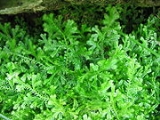
Selaginella kraussiana
Encyclopedia
Selaginella kraussiana, sometimes known by the common names of Krauss's spikemoss and African clubmoss, is a clubmoss
found naturally in the Canary Islands
, the Azores
and parts of mainland Africa
.
since it is an invasive species
. It is common in many parts of New Zealand where it forms dense mats in shaded areas.
Lycopodiopsida
Lycopodiopsida is a class of plants often loosely grouped as the fern allies. Traditionally the group included not only the clubmosses and firmosses, but also the spikemosses and the quillworts...
found naturally in the Canary Islands
Canary Islands
The Canary Islands , also known as the Canaries , is a Spanish archipelago located just off the northwest coast of mainland Africa, 100 km west of the border between Morocco and the Western Sahara. The Canaries are a Spanish autonomous community and an outermost region of the European Union...
, the Azores
Azores
The Archipelago of the Azores is composed of nine volcanic islands situated in the middle of the North Atlantic Ocean, and is located about west from Lisbon and about east from the east coast of North America. The islands, and their economic exclusion zone, form the Autonomous Region of the...
and parts of mainland Africa
Africa
Africa is the world's second largest and second most populous continent, after Asia. At about 30.2 million km² including adjacent islands, it covers 6% of the Earth's total surface area and 20.4% of the total land area...
.
Invasive plant
S. kraussiana is listed on the New Zealand National Pest Plant AccordNational Pest Plant Accord
The National Pest Plant Accord identifies pest plants that are prohibited from sale and commercial propagation and distribution across New Zealand....
since it is an invasive species
Invasive species
"Invasive species", or invasive exotics, is a nomenclature term and categorization phrase used for flora and fauna, and for specific restoration-preservation processes in native habitats, with several definitions....
. It is common in many parts of New Zealand where it forms dense mats in shaded areas.
Cultivation
S. kraussiana is cultivated for ornamental purposes and cultivars include:- 'Aurea'
- 'Brownii'
- 'Gold Tips'

